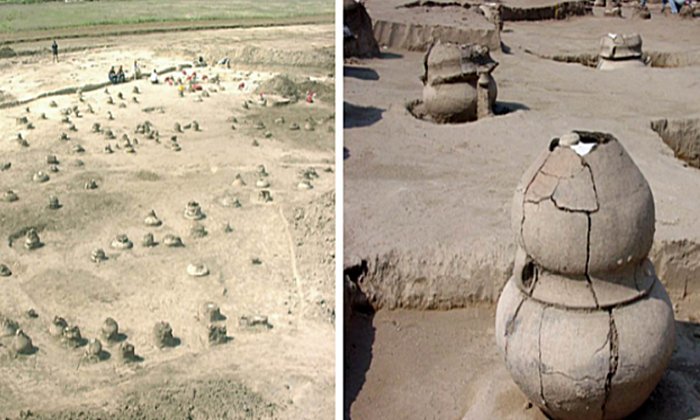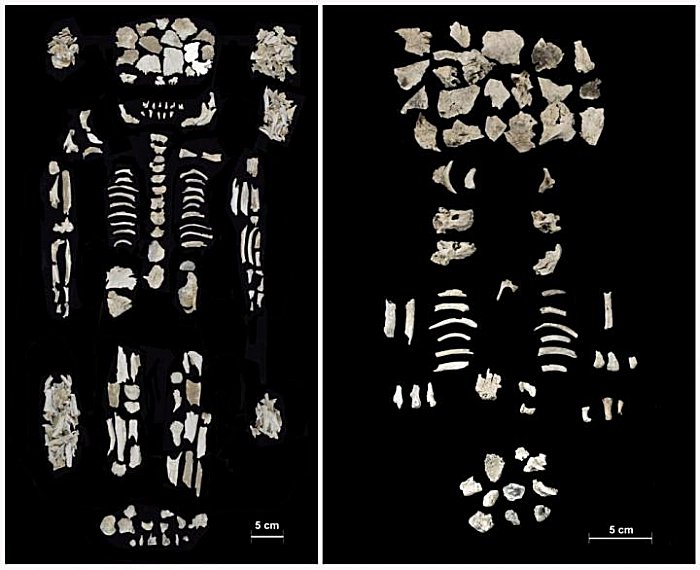Conny Waters – AncientPages.com – Researchers analyzed human tissues of 29 individuals (26 urn cremations and 3 inhumations) from Szigetszentmiklós-Ürgehegy, one of the largest Middle Bronze Age urn cemeteries in Hungary.
The site is located in the northern part of the Csepel Island (a few kilometers south of Budapest) and was in use between c. 2150 and 1500 BC, a period during which the Vatya culture in the plains of Central Hungary experienced the rise, the apogee, and, ultimately, the collapse.
 Szigetszentmiklós-Ürgehegy ‘urnfield’ during excavation and a typical Vatya burial. Image source
Szigetszentmiklós-Ürgehegy ‘urnfield’ during excavation and a typical Vatya burial. Image source
People of the Vatya culture flourished during the Hungarian Early and Middle Bronze Ages (approximately 2200-1450 BC). According to tradition, they cremated the deceased.
The majority of analyzed graves contained the remains of a single individual and simple grave goods made of ceramic or bronze; however, gravesite 241 was of special interest: this grave contained an urn with the cremated remains of an adult woman and two fetuses, buried alongside prestigious grave goods including a golden hair-ring, a bronze neck-ring, and two bone hairpin ornaments.
Though the three inhumed individuals were poorly preserved, the researchers were able to confirm these had been adults, though they couldn’t determine the Sєx. Of the 26 cremated individuals, seven appeared to be adult males, 11 adult females, and two appeared to be adults whose Sєx couldn’t be determined.
 Left: Bone ᴀssemblage from burial n. 241a (adult female individual). Right: Bones attributable to both fetuses (n. 241b and 241c). Credit: Cavazzuti et al, 2021, PLOS ONE (CC-BY 4.0)
Left: Bone ᴀssemblage from burial n. 241a (adult female individual). Right: Bones attributable to both fetuses (n. 241b and 241c). Credit: Cavazzuti et al, 2021, PLOS ONE (CC-BY 4.0)
They also identified children’s remains: two individuals likely 5-10 years of age, and four individuals ranging from 2-5 years of age—the youngest present aside from the twin fetuses buried with the adult woman in grave 241, which were approximately 28-32 gestational weeks of age.
The woman in grave 241 may have died due to complications bearing or birthing these twins. Her remains indicate she was 25 to 35 years old at her time of death and the remains were especially carefully collected post-cremation, as her grave exhibited a bone weight 50 percent higher than the average sampled grave.
The strontium analysis also revealed she was likely born elsewhere and moved to Szigetszentmiklós in early adolescence, between the ages of 8-13. One other adult woman also appeared non-local to Szigetszentmiklós, with the adult women in general featuring a more varied strontium isotope composition than the adult men, whose isotopes were concentrated in an especially small range—even narrower than those of the children analyzed in the study.
The findings reinforce the evidence that women, especially of high rank, commonly married outside their immediate group in Bronze Age Central Europe—and confirm the informative potential of strontium isotope analyses even for cremated remains.
“Thanks to a wide spectrum of new bioarchaeological methods, techniques, and sampling strategies, it is now possible to reconstruct the life-histories of cremated people of the Bronze Age. In this case, the authors investigate the movements and the tragic events of a high-status woman’s life, settled along the Danube 4000 years ago, in the territory of modern-day Hungary,” the authors of the study said.
Paper
Written by Conny Waters – AncientPages.com Staff Writer





